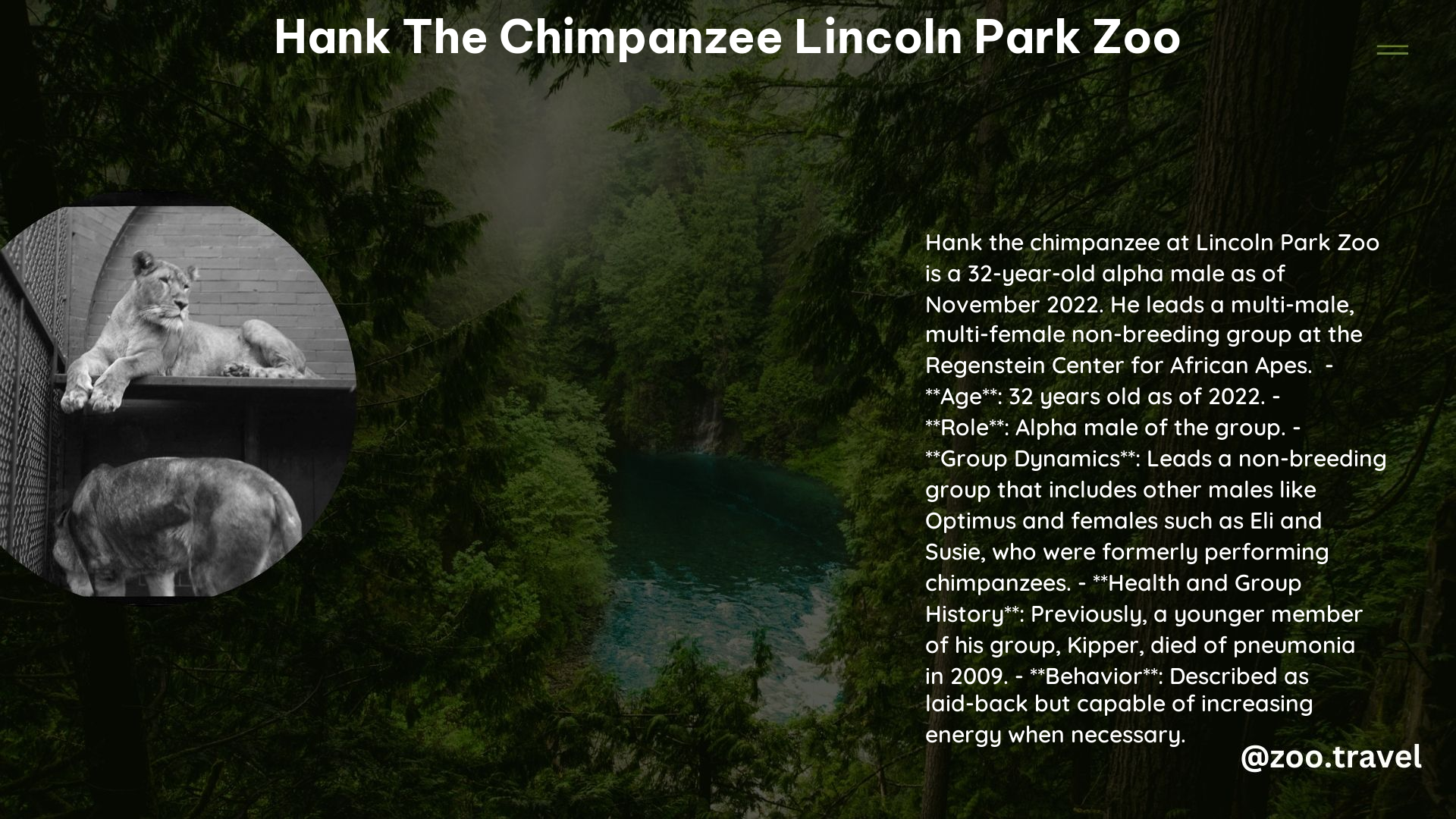Hank, a male chimpanzee at Lincoln Park Zoo’s Regenstein Center for African Apes, is part of a multi-male, multi-female non-breeding group. Known for his social interactions and adaptability, Hank has been a key figure in the zoo’s chimpanzee community for over 15 years. The zoo’s state-of-the-art facility and dedicated care practices have allowed Hank and his group to thrive, providing valuable insights into chimpanzee behavior and welfare. This article explores Hank’s life, habitat, and the zoo’s efforts to ensure his well-being.
Who is Hank and What is His Role in the Chimpanzee Group?

Hank is a male chimpanzee who plays a significant role in the social dynamics of his group at Lincoln Park Zoo. As part of a multi-male, multi-female non-breeding group, Hank’s interactions with other chimpanzees provide valuable insights into chimpanzee behavior and social structures.
Key aspects of Hank’s role include:
- Social Stability: Hank, along with another male named Optimus, is considered a key figure in maintaining group stability.
- Conflict Resolution: He has demonstrated the ability to reconcile after squabbles, a natural and important behavior in chimpanzee societies.
- Adaptability: Hank has shown flexibility in adjusting to changes in group composition, reflecting the natural fission-fusion behavior of wild chimpanzees.
- Research Subject: His behavior is closely monitored by researchers to gain insights into chimpanzee social preferences and needs.
How Does Lincoln Park Zoo Ensure Hank’s Well-being?

Lincoln Park Zoo employs a comprehensive approach to ensure Hank’s physical and mental well-being. The zoo’s care practices are designed to mimic natural conditions while providing the best possible care in a captive environment.
| Care Aspect | Description |
|---|---|
| Habitat Design | State-of-the-art facility with naturalistic features |
| Social Management | Flexible group composition to reflect natural behaviors |
| Enrichment Activities | Regular stimulation to promote natural behaviors |
| Health Monitoring | Close observation by trained staff and veterinarians |
| Research Integration | Ongoing studies to improve care practices |
The Regenstein Center for African Apes, where Hank resides, is specifically designed to cater to the complex needs of chimpanzees. It includes:
- Front-of-scenes and behind-the-scenes habitats
- Private outdoor spaces
- Areas for indirect interaction through sight, smell, and sound
- Flexible spaces for managing group dynamics
What Kind of Enrichment Activities Does Hank Participate In?
Enrichment activities are crucial for maintaining Hank’s mental and physical health. While specific details about Hank’s individual enrichment program are not provided, Lincoln Park Zoo is known for its comprehensive approach to chimpanzee enrichment.
Typical enrichment activities for chimpanzees like Hank may include:
- Puzzle feeders to stimulate problem-solving skills
- Artificial termite mounds to encourage tool use
- Varied diet presentation to mimic foraging behaviors
- Social interaction opportunities with group members
- Novel objects for exploration and manipulation
- Climbing structures to promote physical activity
The zoo’s ChimpCARE tool emphasizes the importance of these activities in promoting chimpanzee welfare. Enrichment programs are designed to stimulate natural behaviors and provide mental and physical challenges that keep Hank and his group members engaged and healthy.
How Do Researchers Study Hank’s Behavior?
Researchers at Lincoln Park Zoo, particularly those from the Lester E. Fisher Center for the Study and Conservation of Apes, conduct ongoing observations of Hank and his group. These studies provide valuable insights into chimpanzee behavior and help improve care practices.
Research methods may include:
- Direct observation of social interactions
- Video recording for detailed behavioral analysis
- Health monitoring to correlate behavior with physical well-being
- Cognitive tests to assess mental acuity and problem-solving skills
- Analysis of group dynamics and individual roles within the social structure
The data collected from observing Hank and his group contributes to a broader understanding of chimpanzee behavior, which in turn informs care practices not only at Lincoln Park Zoo but potentially at other facilities as well.
What Can Visitors Learn from Observing Hank?
Visitors to Lincoln Park Zoo have the unique opportunity to observe Hank and his group, gaining insights into chimpanzee behavior and social structures. This experience can be both educational and inspiring, fostering a connection between humans and our closest living relatives.
Key learning points for visitors include:
- Chimpanzee Social Behavior: Observing how Hank interacts with other group members can demonstrate the complex social dynamics of chimpanzees.
- Problem-Solving Skills: Watching Hank engage with enrichment activities showcases the intelligence and adaptability of chimpanzees.
- Conservation Awareness: Understanding the challenges faced by wild chimpanzees and the importance of conservation efforts.
- Animal Welfare: Seeing the care provided to Hank can educate visitors about the complexities of maintaining animal well-being in captivity.
- Evolutionary Connections: Recognizing similarities between chimpanzee and human behaviors can highlight our evolutionary relationship.
How Does Hank’s Presence Contribute to Chimpanzee Conservation?
While Hank himself is not part of a breeding program, his presence at Lincoln Park Zoo plays a significant role in chimpanzee conservation efforts:
- Public Education: Hank serves as an ambassador for his species, helping to educate the public about chimpanzees and their conservation needs.
- Research Contributions: Studies involving Hank provide valuable data that can be applied to conservation strategies for wild chimpanzees.
- Husbandry Advancements: Insights gained from caring for Hank and his group contribute to improved care practices for chimpanzees in other facilities and potentially in rehabilitation centers.
- Fundraising Support: Hank’s presence helps generate public interest and support for chimpanzee conservation initiatives.
- Policy Influence: Research conducted at Lincoln Park Zoo, including observations of Hank, can inform policy decisions related to chimpanzee protection and habitat conservation.
By studying Hank and his group, researchers and conservationists gain valuable insights that can be applied to the protection of wild chimpanzee populations. This knowledge transfer is a crucial aspect of zoo-based conservation efforts.
What Future Plans Does Lincoln Park Zoo Have for Hank and His Group?
While specific future plans for Hank are not detailed in the provided information, Lincoln Park Zoo’s commitment to chimpanzee welfare and research suggests ongoing efforts to improve and expand their care practices. Potential future initiatives could include:
- Enhanced habitat modifications to further enrich Hank’s environment
- Participation in new behavioral studies to deepen our understanding of chimpanzee cognition
- Integration of cutting-edge technologies for more detailed behavioral monitoring
- Collaboration with other institutions to share best practices in chimpanzee care
- Development of new educational programs centered around Hank and his group to increase public engagement in conservation efforts
The zoo’s partnership with sanctuaries and ongoing research projects indicate a long-term commitment to chimpanzee welfare and conservation, which will likely benefit Hank and his group in the years to come.
In conclusion, Hank the chimpanzee at Lincoln Park Zoo serves as a valuable member of the zoo’s chimpanzee community, contributing to our understanding of these remarkable primates. Through careful management, enrichment, and research, the zoo ensures Hank’s well-being while also advancing chimpanzee conservation efforts. Visitors to the zoo have the unique opportunity to observe Hank and learn about the complexities of chimpanzee behavior and the importance of protecting these intelligent and social animals.
References:
1. https://www.lpzoo.org/science-project/a-zoo-sanctuary-partnership-for-chimpanzees/
2. https://www.lpzoo.org/advancing-chimp-welfare-the-chimpcare-tool/
3. https://www.lpzoo.org/the-complexities-of-care/
